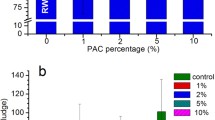Abstract
The fuel acclimation process offers flexibility in microbial fuel cell (MFC) power generation behavior. Different concentrations (50–200 mg/L) of phenol were used for adapting the activated sludge (AS), obtained from a local petroleum wastewater treatment plant and Ralstonia eutropha pure culture. Anodic biomass capable of oxidizing phenol substrate, using either AS inoculum microbial consortium or R. eutropha in the MFC system, has been a reflection of growth supportive functionality of phenol and 150 mg/L as initial concentration was used in the experiments. For both types of inocula. The results of phenol and COD removals obtained for closed system configuration were compared with those under open circuit condition. The current production by AS and R. eutropha was improved through phenol acclimation process. The highest power density (PD) using either AS or R. eutropha was 11 and 5.8 mW/m2, respectively. In terms of using olive oil mill wastewater as the anodic substrate, the behavior of phenol-acclimated R. eutropha was better than that of the synthetic type of wastewater, and the PD value was 7.8 mW/m2.
Similar content being viewed by others
References
B. E. Rittmann, C. I. Torres and A. K. Marcus, Emerging environmental technologies, V. Shah, Springer, New York (2008).
B. D. Shoener, I. M. Bradley, R. D. Cusicka and J. S. Guest, Environ. Sci. Processes Impacts, 16, 1204 (2014).
P. Arroyo and M. Molinos-Senante, Sci. Total Environ., 625, 819 (2018).
J. Cheng, X. Zhu, J. Ni and A. Borthwick, Bioresour. Technol., 101, 2729 (2010).
D. W. Small, D. V. Matyushov and G. A. Voth, J. Am. Chem. Soc., 125(24), 7470 (2003).
J. M. Mayer and I. J. Rhile, Biochim. Biophys. Acta, 1655, 51 (2004).
T. P. Silverstein, J. Chem. Educ., 89, 1159 (2012).
R. Karthikeyan, B. Wang, J. Xuan, J. W. C. Wong, P. K. H. Lee and M. K. H. Leung, Electrochim. Acta, 157, 314 (2015).
J. M. Sonawane, A. Yadav, P. C. Ghosh and S. B. Adeloju, Biosens. Bioelectron., 90, 558 (2017).
Z. He and L. T. Angenent, Bioelectronics, 18, 2009 (2006).
D. Ucar, Y. Zhang and I. Angelidaki, Front. Microbiol., 8, 643 (2017).
J. M. Pisciotta, Z. Zaybak, D. F. Call, J. Y. Nam and B. E. Logan, Appl. Environ. Microbiol., 78, 5212 (2012).
D. K. Amenorfenyo, X. Huang, Y. Zhang, Q. Zeng, N. Zhang, J. Ren and Q. Huang, Int. J. Environ. Res. Public Health, 16, 1910 (2019).
N. V. Pradeep, S. Anupama, K. Navya, H. N. Shalini, M. Idris and U. S. Hampannavar, Appl. Water Sci., 5, 105 (2015).
N. M. R. Shchegolkova, G. S. Krasnov, A. A. Belova, A. A. Dmitriev, S. L. Kharitonov, K. M. Klimina, N. V. Molnikova and A. V. Kudryavtseva, Front. Microbol., 7(FEB) (2016).
M. Tian, D. Du, W. Zhou, X. Zeng and G. Cheng, Braz. J. Microbiol., 48, 305 (2017).
B. Maestro and J. M. Sanz, Microb. Biotechnol., 10(6), 1323 (2017).
H. Bermek, T. Catal, S. S. Akan, M. S. Ulutaş, M. Kumru, M. Özgüven, H. Liu, B. Özçelik and A. T. Akarsubaşı, World J. Microbiol. Biotechnol., 30, 1177 (2014).
M. Ahmadi, F. Vahabzadeh, B. Bonakdarpour, E. Mofarrah and M. Mehranian, J. Hazard. Mater. B, 123, 187 (2005).
E. Jalilnejad, A. Mogharei and F. Vahabzadeh, Environ. Technol., 32, 1085 (2011).
S. V. Mohan, R. Saravanan, S. V. Raghavulu, G. Mohanakrishna and P. N. Sarma, Bioresour. Technol., 99, 596 (2008).
J. D. Box, Water Res., 17, 511 (1983).
A. K. Ghattas, F. Fischer, A. Wick and T. A. Ternes, Water Res., 116, 268 (2017).
D. R. Bond and D. R. Lovley, Appl. Environ. Microbiol., 69, 1548 (2003).
N. S. Malvankar, M. T. Tuominen and D. R. Lovely, Energy Environ. Sci., 5, 5790 (2011).
E. Elakkiya and M. Matheswaran, Bioresour. Technol., 136, 407 (2013).
K. P. Katuri, K. Scotta, I. M. Head, C. Picioreanu and T. P. Curtis, Bioresour. Technol., 102, 2758 (2011).
K. Rabaey, N. Boon, S. D. Siciliano and M. Verhaege, Appl. Environ. Microbiol., 70, 5373 (2004).
B. E. Logan, B. Hamelers, R. Rozendal, U. Schröder, J. Keller, S. Freguia, P. Aelterman, W. Verstraete and K. Rabaey, Environ. Sci. Technol., 40, 5181 (2006).
S. Wu, W. He, W. Yang, Y. Ye, X. Huang and B. E. Logan, J. Power Sources, 356, 348 (2017).
T. Miranda, A. Esteban, S. Rojas, I. Montero and A. Ruiz, Int. J. Mol. Sci., 9, 512 (2008).
T. P. Sciarria, A. Tenca, A. D’Epifanio, B. Mecheri, G. Merlino, M. Barbato, S. Borin, S. Licoccia, V. Garavaglia and F. Adani, Bioresour. Technol., 147, 246 (2013).
Author information
Authors and Affiliations
Corresponding author
Rights and permissions
About this article
Cite this article
Bagheri, M., Daneshvar, R., Mogharei, A. et al. Phenol-acclimated activated sludge and Ralstonia eutropha in a microbial fuel Cell for removal of olive oil from mill wastewater. Korean J. Chem. Eng. 37, 1233–1240 (2020). https://doi.org/10.1007/s11814-020-0538-x
Received:
Revised:
Accepted:
Published:
Issue Date:
DOI: https://doi.org/10.1007/s11814-020-0538-x




